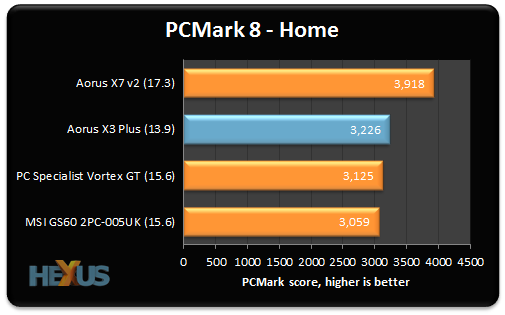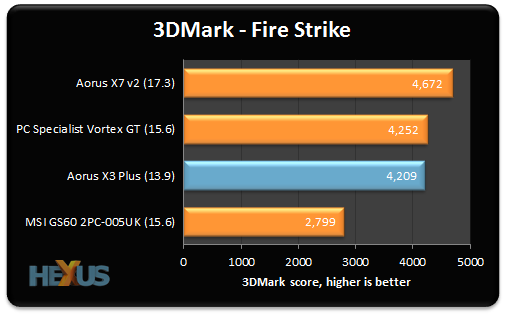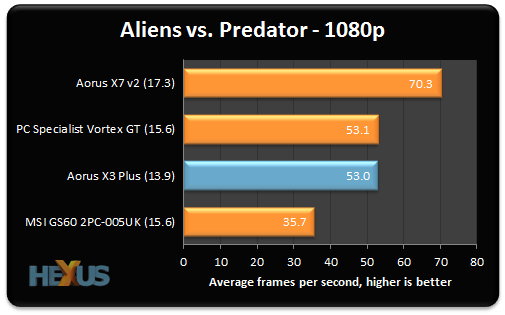Benchmarks: System and Gaming



Overall system performance, unsurprisingly, is very good indeed, and the Kepler-powered GeForce GTX 870M offers true gaming potential. The X3 Plus may be smaller than most gaming laptops, yet it can be every bit as fast.
1080p Gaming Performance (Average FPS) |
||||||
|---|---|---|---|---|---|---|
| Game | Quality Settings | Laptop |
Desktop |
|||
Aorus X3 |
||||||
(Nvidia GeForce GTX 870M 6GB) |
(2x Nvidia GeForce GTX 860M 4GB) |
(Nvidia GeForce GTX 870M 6GB) |
(Nvidia GeForce GTX 860M 2GB) |
(Palit GeForce GTX 660 2GB) |
||
| BioShock Infinite | Very Low Quality | 168.6 |
198.4 |
155.8 |
121.6 |
- |
| Low Quality | 124.7 |
153.0 |
120.9 |
90.0 |
- |
|
| Medium Quality | 101.0 |
127.2 |
100.1 |
73.1 |
98.8 |
|
| High Quality | 86.1 |
106.9 |
85.6 |
61.4 |
89.5 |
|
| Max Quality | 51.4 |
63.5 |
52.2 |
35.6 |
54.4 |
|
| Total War: Rome II | Low | 127.5 |
102.8 |
120.7 |
90.3 |
- |
| Medium Quality | 121.9 |
96.7 |
115.0 |
85.3 |
124.2 |
|
| High Quality | 104.3 |
81.9 |
99.4 |
72.5 |
- |
|
| Very High Quality | 60.3 |
46.0 |
60.4 |
44.0 |
56.1 |
|
| Extreme Quality | 29.4 |
22.1 |
30.6 |
21.6 |
25.3 |
|
To get a better feel for the laptop's true gaming capabilities, we've run a couple of games at a standard 1080p resolution. The results are right in line with expectations, and the X3 Plus has no trouble delivering in excess of 60 frames per second with very-high quality settings. It's interesting to note that the X3 Plus is quicker than the dual-GPU X7 v2 in Total War: Rome II - that's a direct benefit of having a single GPU and avoiding the potential foibles of SLI gaming.
Native Gaming Performance - 3,200x1,800 (Average FPS) |
||
|---|---|---|
| Game | Quality Settings | Aorus X3 |
(Nvidia GeForce GTX 870M 6GB) |
||
| BioShock Infinite | Very Low Quality | 79.8 |
| Low Quality | 55.2 |
|
| Medium Quality | 42.8 |
|
| High Quality | 36.8 |
|
| Max Quality | 22.3 |
|
| Total War: Rome II | Low | 59.5 |
| Medium Quality | 55.4 |
|
| High Quality | 49.5 |
|
| Very High Quality | 27.6 |
|
| Extreme Quality | 12.2 |
|
1080p scales well and looks good on the X3 Plus' 13.9in display, but crank up the resolution to 3,200x1,800 and games tend to go from good to jaw-dropping. Trouble is, pushing 264 pixels-per-inch requires a serious amount of graphics horsepower. Is the GTX 870M up to the job? Perhaps, though you will need to lower image quality in order to maintain playable frame rates.
You can't have it all your own way on current hardware, so it's a toss-up between 1080p at high/max quality, or 1800p at low/medium quality. It's a personal preference, and we actually prefer the latter.









